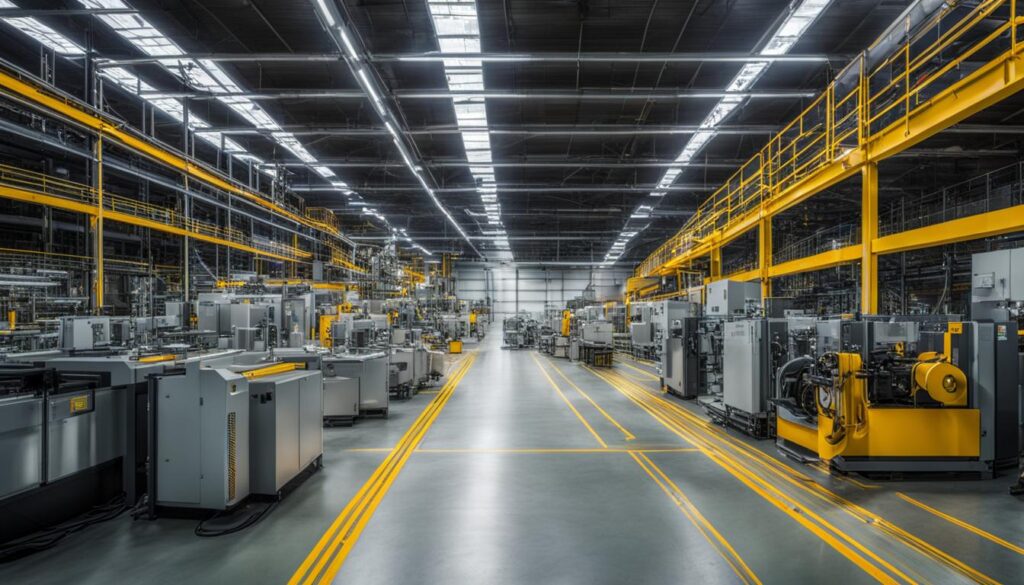Welcome to the world of OT information technology (OT IT)! In this article, we will demystify the concept of OT Information Technology and provide you with a clear understanding of its definition, meaning, and basics. OT IT refers to the integration of information technology systems with operational technology systems, bridging the gap between the physical industrial world and the digital realm of data processing.
OT IT entails managing and controlling physical devices and processes (OT) while leveraging information technology systems (IT) for processing, storing, and exchanging electronic data. This convergence has become possible with advancements in technologies like the Internet of Things (IoT) and big data analytics. By merging IT with OT, businesses gain improved insights, controls, and efficiencies in their industrial operations.
- OT IT combines information technology systems with operational technology systems.
- It bridges the physical and digital worlds.
- Advancements in technologies like IoT enable IT and OT convergence.
- Converging IT and OT offers improved insights, controls, and efficiencies for industrial operations.
- OT IT is crucial in the era of Industry 4.0 and the Industrial Internet of Things (IIoT).
Contents
What is OT Technology?
OT technology, also known as Operational Technology technology, encompasses the hardware and software systems used in industrial, manufacturing, and process control environments. It plays a crucial role in optimizing and managing complex industrial operations.
At its core, OT technology focuses on monitoring and controlling physical devices and processes in industrial settings. It involves the integration of various industrial control systems, such as Supervisory Control and Data Acquisition (SCADA), which gather and analyze real-time data for effective management of plant equipment and operations.
OT devices are often characterized by their autonomous nature and reliance on proprietary software. They are designed to handle the unique challenges of industrial environments, where the seamless functioning and precise control of physical equipment are paramount.
Key components of OT technology include:
- Sensors: These devices detect and measure physical parameters, such as temperature, pressure, and humidity, enabling real-time monitoring of industrial processes.
- Relays: Used for controlling the flow of electricity in electrical circuits, relays play a critical role in ensuring the safe and efficient operation of industrial machinery.
- Programmable Logic Controllers (PLCs): PLCs are specialized computers that automate the control of industrial processes and machinery. They are capable of executing specific instructions and responding to inputs from sensors and other devices.
OT technology enables industrial organizations to achieve greater efficiency, reliability, and safety in their operations. By leveraging the capabilities of advanced hardware and software systems, businesses can enhance productivity, minimize downtime, and optimize resource utilization.
OT technology brings together the physical and digital realms, enabling the seamless integration of industrial processes and information systems.
IT vs OT: Key Differences
When it comes to information technology (IT) and operational technology (OT), there are several key differences that set them apart. Understanding these distinctions is essential for organizations looking to optimize their cybersecurity strategies and harness the benefits of IT/OT convergence.
IT Systems
In the realm of IT, the primary focus is on data processing. IT systems rely on standardized operating systems like Windows and Linux and take a more user and data-centric approach. These systems handle the processing, storage, and exchange of electronic data, enabling organizations to manage and analyze information effectively. IT cybersecurity mainly revolves around safeguarding data confidentiality.
OT Systems
OT technology, on the other hand, is all about real-time control of physical devices and processes. OT systems run on proprietary software and employ specialized protocols for communication. These systems include industrial control systems such as supervisory control and data acquisition (SCADA), which monitor and manage equipment in industrial environments. OT cybersecurity focuses on ensuring the availability and safety of critical equipment and processes.
“IT systems handle data processing, while OT systems focus on the control of physical devices.”
The table below provides a comprehensive overview of the key differences between IT and OT:
| Aspect | IT | OT |
|---|---|---|
| Focus | Data processing | Real-time control of physical devices |
| Operating Systems | Standardized (e.g., Windows, Linux) | Proprietary |
| Communication Protocols | – | Specialized protocols for industrial environments |
| Main Goal | Data confidentiality | Equipment/process availability and safety |
Understanding the differences between IT and OT is crucial for implementing robust cybersecurity measures across both domains. By recognizing these distinctions, organizations can develop comprehensive strategies that protect data integrity, ensure operational stability, and enable secure IT/OT convergence.

Benefits of IT/OT Convergence
Converging IT and OT systems offers numerous benefits that can significantly impact your business. By integrating these two worlds, you can unlock new opportunities and take advantage of synergies between information technology and operational technology. Here are some of the key benefits of IT/OT convergence:
1. Cost Savings
One of the main advantages of IT/OT convergence is cost savings. By eliminating the need for separate networks and infrastructure, you can reduce operational expenses and streamline your IT and OT environments. This consolidation not only reduces maintenance and hardware costs but also simplifies system management and improves overall efficiency.
2. Enhanced Business Processes
When IT and OT systems converge, the sharing of data becomes seamless, allowing for improved business processes. With real-time data integration, you can gain valuable insights into your operations, identify bottlenecks, and optimize your production processes. This enables you to make data-driven decisions quickly and efficiently, enhancing productivity and overall business performance.
3. Improved Security
Implementing IT security measures in your OT environments can significantly strengthen your overall security posture. By leveraging the expertise of IT professionals and adopting best practices in cybersecurity, you can enhance visibility, detect potential threats, and respond quickly to mitigate risks. This proactive approach to security ensures the safety and availability of critical equipment and processes.
4. Advanced Analytics and Interpretation
The convergence of IT and OT allows for more effective data analysis and interpretation through the combination of artificial intelligence (AI) and machine learning. By leveraging these technologies, you can unlock valuable insights from your data, identify patterns, and predict future trends. This enables you to make proactive decisions, optimize your operations, and stay ahead of the competition.
Overall, the benefits of IT/OT convergence are far-reaching and can pave the way for digital transformation in your organization. From cost savings to improved security and enhanced data analytics, embracing this convergence can propel your business forward in today’s data-driven world.
| Benefits of IT/OT Convergence |
|---|
| Cost Savings |
| Enhanced Business Processes |
| Improved Security |
| Advanced Analytics and Interpretation |

IT/OT Convergence Use Cases
Let’s take a look at a few examples of how IT/OT convergence is being applied in different industries:
- In the manufacturing industry, IT/OT convergence enables the optimization of production processes through real-time data analysis. By integrating IT systems with OT devices on the shop floor, manufacturers can monitor equipment performance, identify inefficiencies, and make data-driven adjustments to improve overall productivity.
- In the energy sector, IT/OT convergence plays a crucial role in the management and control of power generation and distribution systems. By integrating IT infrastructure with OT devices like smart meters and SCADA systems, energy companies can monitor energy consumption, detect faults, and optimize resource allocation for more efficient operations.
- In the telecommunications industry, IT/OT convergence allows for seamless connectivity and enhanced network management. By integrating IT systems with OT devices such as cell towers and network switches, telecom companies can improve network performance, troubleshoot issues in real-time, and provide better quality of service to their customers.
- In the water control industry, IT/OT convergence enables efficient monitoring and management of water distribution systems. By integrating IT systems with OT devices like flow sensors and control valves, water control authorities can monitor water levels, detect leaks, and optimize water supply to ensure efficient distribution and conservation.
IT/OT Convergence Benefits
The convergence of IT and OT systems brings several benefits to industries, including:
- Optimized operations through real-time data analysis and decision-making.
- Improved resource allocation and utilization.
- Enhanced safety and security through centralized monitoring and control.
- Streamlined processes and reduced downtime.
- Increased efficiency and productivity.
By leveraging IT/OT convergence, organizations can unlock new opportunities and stay competitive in today’s rapidly evolving industrial landscape.
| Industry | IT/OT Convergence Use Case |
|---|---|
| Manufacturing | Optimizing production processes through real-time data analysis |
| Energy | Efficient management and control of power generation and distribution systems |
| Telecommunications | Seamless connectivity and enhanced network management |
| Water Control | Efficient monitoring and management of water distribution systems |
Conclusion
In conclusion, IT/OT convergence brings together the worlds of information technology and operational technology to revolutionize industrial processes. By integrating these systems, organizations can realize a wide range of benefits for their operations.
Firstly, IT/OT convergence enables cost savings by eliminating the need for separate networks and infrastructure. By sharing data between IT and OT systems, organizations can optimize their business processes, improve supply chain management, and make real-time decisions based on accurate and up-to-date information.
Moreover, IT/OT convergence enhances security measures by implementing IT cybersecurity protocols in OT environments. This ensures the availability and safety of critical equipment and processes, strengthening the overall security posture of industrial operations.
While IT/OT convergence offers significant advantages, there are also challenges that must be addressed. Connectivity issues, patching requirements, and interoperability considerations require careful planning and execution. However, by overcoming these obstacles, organizations can fully harness the potential of IT/OT convergence and drive efficiency, productivity, and competitiveness in various industries.
FAQ
What is OT information technology?
OT information technology refers to the integration of information technology systems with operational technology systems. It involves the convergence of the physical industrial world and the digital world of data processing.
What is OT technology?
OT technology refers to the hardware and software systems used in industrial, manufacturing, and process control systems. It includes industrial control systems like supervisory control and data acquisition (SCADA) and focuses on monitoring and controlling physical devices and processes in industrial environments.
What are the key differences between IT and OT?
IT systems are focused on data processing, use standardized operating systems like Windows and Linux, and have a more user and data-centric approach. OT systems are focused on the real-time control of physical devices, run on proprietary software, and have specialized protocols for communication.
What are the benefits of IT/OT convergence?
IT/OT convergence can lead to cost savings by reducing the need for separate networks, enhance business processes through improved data sharing, and strengthen security by implementing IT security measures in OT environments. It also enables real-time decision-making and more effective data analysis and interpretation.
What obstacles need to be overcome for IT/OT convergence?
Some challenges of IT/OT convergence include dealing with a large number of devices in OT networks, balancing firmware and software updates in OT systems, addressing different types of data, and ensuring interoperability between IT and OT networks.
In which industries is IT/OT convergence used?
IT/OT convergence is used in various industries such as manufacturing, energy, oil and gas, telecommunications, and water control. It enhances productivity, safety, and efficiency in these industries through the integration of automation, communications, and networking.




